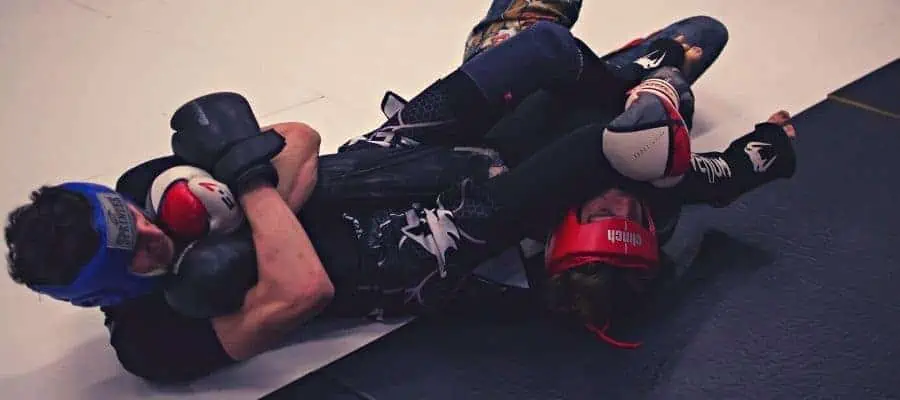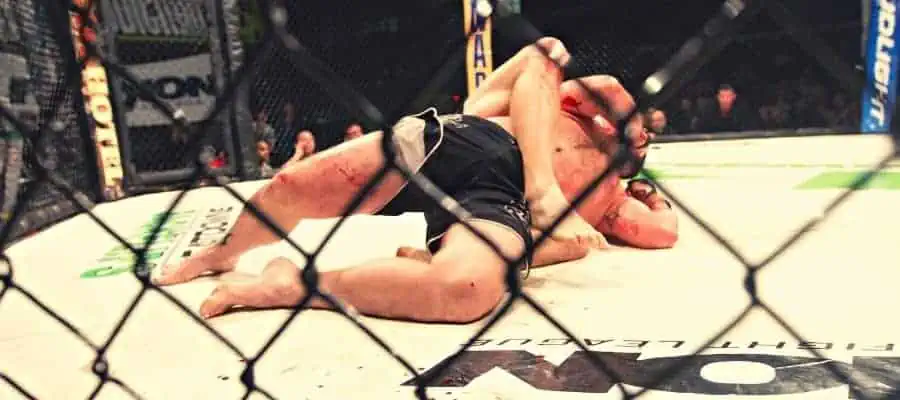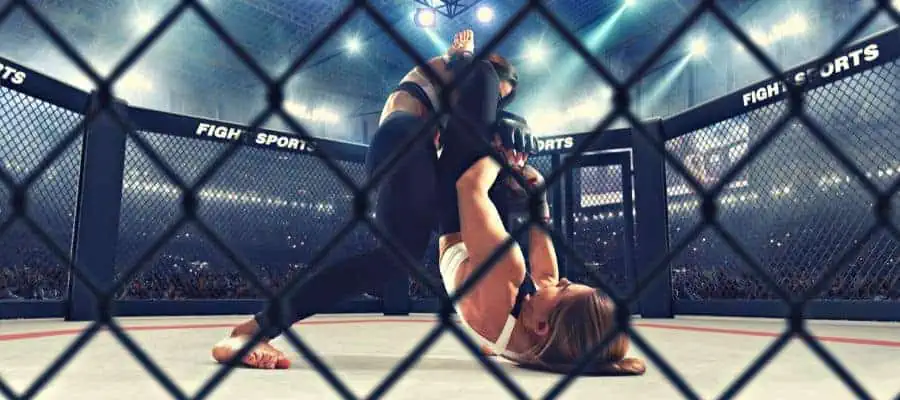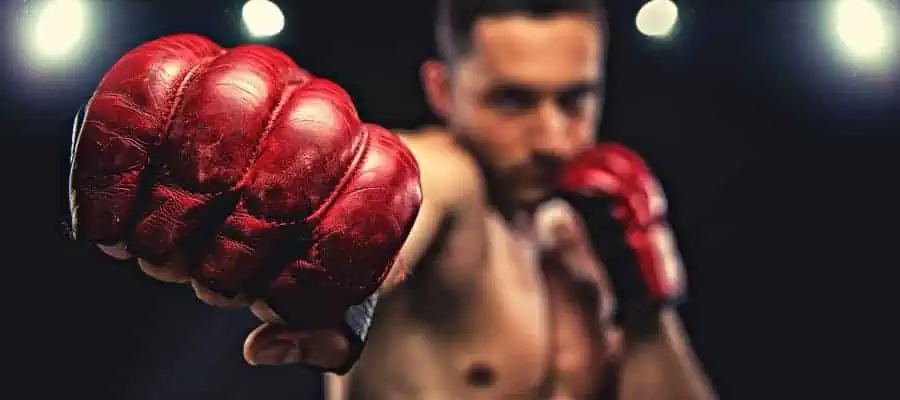Mixed martial arts, or MMA, is a combat sport that combines techniques from various martial arts, including striking, grappling, and submission techniques. MMA fighters compete in a cage with the goal of defeating their opponent through a combination of strikes, takedowns, and submissions. MMA has gained popularity over the years, thanks in part to its fast-paced action and the skill and athleticism of its fighters.
However, MMA is also considered one of the hardest martial arts, with various physical and mental demands pushing fighters to their limits. So, there are some reasons why MMA is so challenging and what it takes to succeed in this demanding sport.
Wide Range Of Techniques

MMA combines techniques from various martial arts, including boxing, Muay Thai, wrestling, Brazilian Jiu-Jitsu, and many others. As a result, fighters must be proficient in multiple disciplines and constantly work to improve their skills. Striking, grappling, clinch work, and ground fighting all require different techniques and strategies, and fighters must be able to switch between them seamlessly.
MMA is often called the “complete” martial art, as it combines various techniques from different disciplines. Striking is a crucial component of MMA, and fighters must be able to use punches, kicks, knees, and elbows effectively.
Grappling, including wrestling and Brazilian Jiu-Jitsu, is also a key part of the sport. Clinch work, which involves controlling an opponent at close range, is another important technique. Finally, ground fighting, which involves controlling and submitting an opponent on the ground, is vital to MMA.
To succeed in MMA, fighters must have a deep understanding of these different techniques and be able to use them to defeat their opponents. This requires a significant amount of training and practice and the ability to adapt to different opponents and styles.
Physical Demands

MMA fighters must be in excellent physical condition to perform at a high level. The sport demands high strength, endurance, speed, and agility. Fighters must be able to maintain a high pace throughout a fight, which can last anywhere from a few minutes to five rounds of five minutes each. Fighters must train tirelessly to improve their physical attributes and ensure they can perform at their best.
To meet the physical demands of MMA, fighters must have a comprehensive training regimen that includes strength and conditioning, cardiovascular training, and skill-specific training. Fighters must also pay close attention to their diet and nutrition to ensure they have the energy and nutrients they need to perform at their best.
Weight cutting is another hurdle fighters must overcome since many of them cut up to 20 lbs before a fight, which can be quite taxing on the body and the mind. In addition to physical training, fighters must also be able to recover quickly between fights. This requires proper rest, hydration, nutrition, and techniques such as massage, stretching, and other forms of recovery.
Mental Toughness And Strong Mental Game

MMA fighters must possess high mental toughness and develop a strong mental game. The sport demands tremendous focus, discipline, and the ability to remain calm under pressure. Fighters must be able to manage their emotions, overcome setbacks, and stay focused on the task at hand. Mental preparation, visualization, and mental resilience are all crucial to success in MMA.
In MMA, fighters must be able to handle the pressure of competition and the expectations of their coaches, teammates, and fans. They must overcome setbacks, such as losses or injuries, and stay focused on their goals. Mental preparation is also important, and fighters must develop a pre-fight routine that helps them stay focused and calm.
Visualization is another key mental technique in MMA. Fighters must be able to visualize themselves performing at a high level and overcoming their opponents. This helps them build confidence and stay focused on their goals.
Mental resilience is also crucial in MMA. Fighters must be able to bounce back from setbacks and overcome adversity. This requires a strong sense of determination and the ability to stay focused on the long-term goal of becoming a successful fighter.
Fast-Paced

MMA fights are fast-paced and intense. Rounds last only a few minutes, and fighters must be able to maintain a high level of intensity throughout the fight. This demands a high level of stamina and endurance from the fighters and the ability to recover quickly between rounds.
In addition to physical conditioning, fighters must also develop their cardio and endurance through specific training techniques. High-intensity interval training, running, and other forms of cardiovascular training are essential to building endurance and stamina. Fighters must also be able to recover quickly between rounds, which requires proper rest, hydration, and nutrition.
High Risk Of Injury

Due to the nature of the sport, fighters are at a high risk of injury. Broken bones, concussions, joint dislocations, and other injuries are common in MMA. Fighters must take steps to minimize their risk of injury, such as working with skilled coaches and training partners, using proper techniques, and using protective equipment.
An injury can prevent a fighter from competing for up to a year, with knee injuries being the most prevalent. A fighter who cannot compete cannot earn for himself and his family. Combine that with their low pay; a single injury can devastate a fighter’s career.
Fighters must also be able to manage injuries when they occur. This requires working with medical professionals to develop a treatment plan and a rehabilitation program. It also requires mental toughness to overcome setbacks and stay focused on the long-term goal of becoming a successful fighter.
Emphasis On Ground Fighting

MMA places a significant emphasis on ground fighting, which involves a complex array of techniques and requires a high level of skill and strategy. Fighters must be able to control their opponent on the ground, defend against submissions, and use submissions to defeat their opponent.
Ground fighting is often considered the most technical aspect of MMA. Fighters must be able to use various techniques, including sweeps, guard passes, and submissions, to control their opponent and gain an advantage. They must also be able to defend against their opponent’s attacks and escape from unfavorable positions.
To succeed in ground fighting, fighters must have a strong technical foundation and the ability to adapt to different opponents and styles. They must also have a high level of physical conditioning, as ground fighting can be physically demanding and requires a lot of energy.
Additionally, a fighter can only compete at a high level with at least somewhat good grappling/ wrestling technique. That’s why fighters who come from a wrestling/grappling background often have the upper hand since it seems that it is somewhat easier to learn striking than it is to learn grappling to a high degree.
Take Khabib, for example; his standup game wasn’t that good, but his ground game more than made up for it. If he managed to catch one of your legs, you lost the fight 99% of the time.
Weight Cutting

Weight cutting is a significant aspect of MMA that can be physically and mentally taxing. Fighters often need to cut weight to make weight for their fights, which involves reducing their body weight to reach a certain weight class.
The process of weight-cutting can be dangerous if done improperly and can have negative effects on a fighter’s health and performance. Fighters may use various techniques to cut weight, including restricting food and water intake, using saunas or steam rooms to sweat, and taking diuretics.
To cut weight safely and effectively, fighters must work with a nutritionist and a coach to develop a plan that includes proper nutrition and hydration and a gradual reduction in weight leading up to the fight. They must also be careful not to cut too much weight, which can lead to dehydration, loss of strength, and other negative effects.
Constant Training

MMA fighters must train consistently and intensely to maintain their level of skill and conditioning, which can be physically and mentally exhausting. Fighters must devote many hours each day to training, including sparring, drilling, cardio, strength and conditioning, and other forms of training.
Fighters often train up to three times per day, with most of them training twice daily with only one rest day. This often leads to overtraining since many fighters don’t want to fall behind in the competition. Fighters must learn to balance their training with rest and recovery to avoid burnout. They must also find ways to stay motivated and focused, even when training becomes difficult or tedious.
Pressure To Perform

Fighters often face intense pressure to perform as they compete in front of large crowds and millions of viewers. They must be able to handle the pressure and stay focused on their goals, even when the stakes are high.
To perform at their best under pressure, fighters must develop mental techniques that help them stay focused and calm. Visualization, meditation, and other forms of mental preparation can be effective in helping fighters stay focused and perform at their best. Fighters must also learn to manage their emotions and stay calm under pressure.
High Level Of Competition

MMA is a highly competitive sport, with fighters constantly competing to move up the rankings and earn more significant opportunities. The level of competition is high, and fighters must be able to adapt to different opponents and styles.
One example of the high level of competition in MMA is the rivalry between Jon Jones and Daniel Cormier. Jones and Cormier were two of the best fighters in the sport and have faced each other twice in highly anticipated matches. Their rivalry has captured fans’ attention and helped elevate both fighters to the top of the sport.
Another example of the high level of competition in MMA is the constant turnover in the rankings. Fighters must earn their place in the rankings through impressive performances. A single loss can cause a fighter to drop several spots. This constant turnover keeps the sport fresh and exciting and ensures that only the best fighters rise to the top.
To succeed in MMA, fighters must constantly improve their skills and remain at the top of their game. They must also be able to analyze their opponents and develop a game plan that takes advantage of their opponent’s weaknesses. The high level of competition ensures that only the best fighters rise to the top and that each fight is a challenge that demands the fighter’s best effort.
Multi-Dimensional Approach

As a mixed martial art, MMA requires fighters to be skilled in various areas, including striking, grappling, clinch work, and ground fighting. This multi-dimensional approach makes MMA a challenging sport that demands high skill and strategy.
To succeed in MMA, fighters must have a comprehensive training program that includes training in these areas. They must also be able to integrate their skills and techniques into a cohesive game plan that takes advantage of their strengths and exploits their opponent’s weaknesses.
Adaptability

Fighters must adapt to different opponents and styles, as each fighter brings unique strengths and weaknesses to the ring. This requires high flexibility and the ability to adjust to changing circumstances.
To be adaptable in MMA, fighters must have diverse skills and techniques that allow them to switch between striking and grappling and adapt to different styles of opponents. They must also be able to analyze their opponents and adjust during the fight to take advantage of their opponent’s weaknesses.
Constant Evolution

MMA is a relatively new sport, and techniques and strategies continually evolve. Fighters must stay up to date with the latest developments to remain competitive.
One example of the constant evolution in MMA is the rise of leg kicks as a striking technique. Leg kicks have become increasingly popular in recent years as fighters have discovered their effectiveness in wearing down opponents and limiting their mobility. Fighters who adapt to this trend avoid falling behind and being disadvantaged in the ring.
Another example of the constant evolution in MMA is the increased emphasis on grappling and ground fighting. As the sport has evolved, fighters have become more skilled in these areas, and many fights now end with submissions or ground-and-pound techniques.
To stay up to date with the latest developments in MMA, fighters must study the sport and work with coaches and training partners who are knowledgeable about the latest techniques and strategies. They must also be willing to experiment with new techniques and strategies to find what works best for them.
Fan Appeal

Fan appeal is essential to MMA, as fighters must connect with fans to succeed in the sport. Showmanship and the ability to promote oneself can be just as crucial as a fighter’s technical abilities.
One example of a fighter with strong fan appeal is Conor McGregor. McGregor is known for his unique personality, trash-talking, and flashy fighting style. He has a large following on social media and has become one of the most recognizable fighters in the sport. McGregor’s fan appeal has helped him secure more significant opportunities, such as his high-profile fights against Floyd Mayweather Jr. and Khabib Nurmagomedov.
Another example of a fighter with strong fan appeal is Ronda Rousey. Rousey was one of the pioneers of women’s MMA and became a fan favorite due to her dominant fighting style and charismatic personality. Rousey’s fan appeal helped her become a global superstar and a trailblazer for women in combat sports.
In addition to their fighting abilities, fighters must develop a unique personality and fighting style that resonates with fans. They must also be able to promote themselves through social media, interviews, and other forms of media to build a strong fan base that can help them become more successful in the sport.
Weight Of Expectations

MMA fighters often face the weight of expectations from themselves, their coaches, their fans, and the media. The pressure to live up to these expectations can be immense. It can affect a fighter’s mental and physical performance in the ring.
To manage the weight of expectations, fighters must learn to stay focused on their goals and block out distractions. They must also develop a support system that includes coaches, training partners, and other professionals who can help them manage the pressure and stay focused on their goals.
Conclusion
MMA is a challenging and demanding martial art that requires high skill, athleticism, and mental toughness. Fighters must be proficient in a wide range of techniques and be able to adapt to different opponents and styles. They must also be able to manage the physical and mental demands of the sport, as well as the pressure to perform under high-stakes circumstances.
Recent Posts
What is Manachai's Fighting Style? Unveiling Muay Thai Mastery
Manachai, a celebrated figure in the Muay Thai world, has captivated audiences with his exemplary martial prowess. Hailing from the heartlands of Thailand, his name is synonymous with the art of...
What Was Chamuekpet Hapalang's Fighting Style? Unveiling Techniques
Chamuekpet Hapalang was a renowned figure in the world of Muay Thai (record 200-48-2), embodying a fusion of Muay Bouk and Muay Khao styles. Originating from Thailand, the art of Muay Thai is known...
